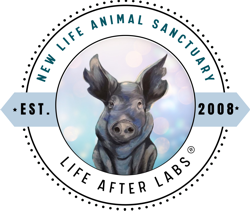Animal Use in Laboratories
Please note that the following information contains facts and figures from primary source documents, such as reports released by the United States government, as well as domestic and international legislature. It is our wish to share the plight of animals in laboratories using only verifiable facts so that the public may understand the objective reality of the situation.
Overall Numbers
Every year, the United States Department of Agriculture (USDA)’s Animal Health Inspection Services (APHIS) releases a report detailing the use of animals in experiments.
Many people have an image of easily-dismissed (for some) “pest” animals like mice and rats doing the bulk of the suffering in laboratories, without ever knowing how many “beloved” species are enduring the same treatment. According to the 2019 report (the one most recently released as of spring 2021), the breakdowns of reported animal usage in USDA-registered and federal facilities for that year was as follows:
DOGS: 58,511
CATS: 18,270
GUINEA PIGS: 181,993
HAMSTERS: 98,296
NONHUMAN PRIMATES: 68,257
PIGS: 50,777
RABBITS: 142,472
SHEEP: 13,953
OTHER COVERED SPECIES: 165,017*
TOTAL: 797,546
Note the asterisk next to “covered species” – the Animal Welfare Act (AWA) intentionally excludes “rats of the genus rattus, mice of the genus mus, and birds bred for use in research” from being under its protection. That means that animals we perhaps most associate with animal testing are being used in quite literally untold numbers. With guinea pigs and hamsters
making up a combined total of 280,289 of the animals on which testing was reported, it is safe to assume that at least as many rats and mice meet the same fate, easily putting the number of total animals in laboratories in the United States at well over a million creatures. Take into consideration the fact that reptiles and fish are also not covered under the AWA and the number grows even larger.
Animal testing for cosmetics
Many countries – including the whole European Union, Israel, India, Norway, Taiwan, and New Zealand – have outlawed the testing of cosmetics on living animals.
Unfortunately, the United States of America is not among these countries.
We hope the world will continue to follow the lead of the countries having already banned cosmetics testing on animals, and even in the United States our legislation is trending in that direction, with Illinois, California, and Nevada all passing laws banning animal testing for the purpose of cosmetics.
Until then, we will continue to provide healthcare and emotional rehabilitation to animals who have survived the cosmetic testing process (among others).
References
USDA/APHIS
https://www.aphis.usda.gov/aphis/ourfocus/animalwelfare/sa_obtain_research_facility_annual_r
eport/ct_research_facility_annual_summary_reports
USDA/APHIS 2019 https://www.aphis.usda.gov/animal_welfare/annual-reports/2019/fy19-
summary-report-column-F.pdf
HSUS = https://www.humanesociety.org/all-our-fights/ending-cosmetics-animal-testing
HSUS FAQ = https://www.humanesociety.org/resources/cosmetics-testing-faq




